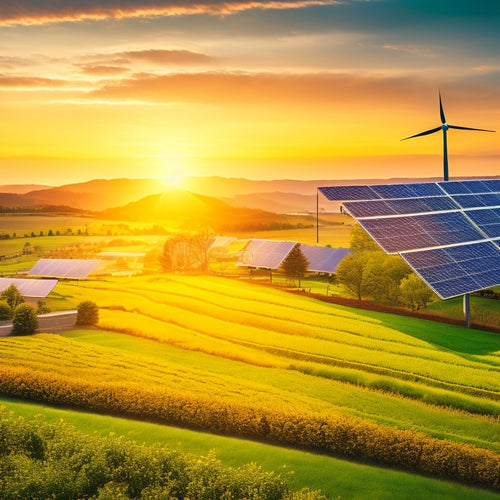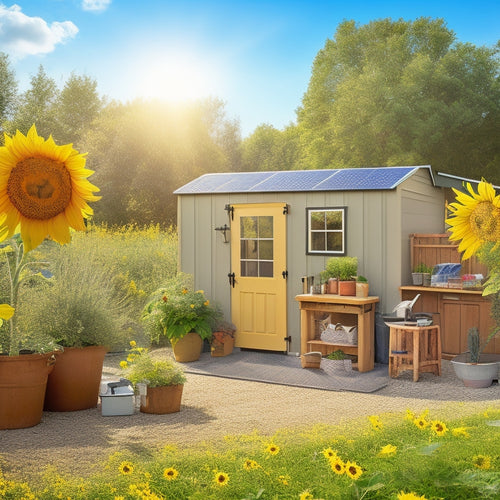
Most Environmentally Friendly Off Grid Power Solutions
Share
If you're considering off-grid power, solar panels and wind turbines are top choices for an environmentally friendly solution. These systems can reduce your carbon footprint by up to 80%, aligning with sustainability goals. Solar power offers energy independence and reliability, while wind turbines utilize consistent wind flows for significant electricity generation. Both options require careful assessment of your daily energy needs to maximize efficiency and cost-effectiveness. With minimal operational costs post-installation, you'll achieve long-term savings. Exploring each renewable source in detail reveals their specific advantages and suitability for your energy requirements, leading to informed decisions for a sustainable future.
At a Glance
- Solar power systems offer energy independence and reliability, especially in rural areas with high-efficiency panels maximizing output.
- Wind energy turbines are effective in areas with consistent winds, providing scalable solutions for various energy needs.
- Biomass, geothermal, hydroelectric, and tidal power present diverse renewable energy options to minimize environmental impact.
- Regular maintenance of off-grid systems enhances efficiency and longevity, preventing costly repairs and improving performance.
- Utilizing renewable energy sources significantly lowers carbon footprints, supporting sustainability and reducing reliance on fossil fuels.
Sustainable Energy Source Options
When considering sustainable energy source options for off-grid systems, solar power systems and wind energy turbines stand out as efficient choices.
Off-grid solar systems enable energy independence and provide a reliable source of electricity, especially in rural areas. You can utilize solar energy through photovoltaic panels, converting sunlight directly into electricity for your needs.
Alternatively, wind turbines can generate power by capturing wind flow, offering a reliable solution in areas with consistent wind patterns.
Innovative energy solutions are essential for maximizing the benefits of these renewable resources.
Solar Power Systems
As you investigate sustainable energy source options, solar power systems emerge as a leading choice due to their efficiency and scalability.
Solar panel efficiency is a crucial factor in determining how much energy you can generate. High-efficiency panels convert a greater percentage of sunlight into electricity, maximizing your output even in limited space.
When considering your setup, you'll encounter various solar inverter types, including string inverters, microinverters, and power optimizers. Each type has its advantages, with microinverters often providing better performance in partially shaded environments.
Choosing the right components is essential for optimizing your solar system's performance. For instance, if you prioritize energy independence, investing in high-efficiency panels paired with microinverters can enhance your system's reliability and adaptability.
You'll also want to evaluate your energy consumption patterns to design a system that meets your needs while reducing reliance on grid power.
Wind Energy Turbines
Wind energy turbines represent a powerful alternative for sustainable energy generation, capable of producing significant amounts of electricity even in moderate wind conditions. By utilizing the kinetic energy of the wind, these turbines provide one of the most effective off-grid power solutions available today.
One of the key wind energy advantages is their scalability. You can choose from small residential units to larger commercial turbines, catering to your specific energy needs. Additionally, wind energy systems often have low operating costs once installed, allowing you to enjoy long-term savings.
When considering turbine installation, it's essential to evaluate your location's wind resources. Conducting a wind assessment helps determine if your site can generate sufficient energy to justify the investment. Proper installation guarantees that turbines operate efficiently, maximizing energy capture while minimizing maintenance issues.
Moreover, wind energy contributes to energy independence. By generating your own power, you reduce reliance on fossil fuels and utility companies, promoting a sustainable lifestyle.
Cost-Effective Long-Term Investment
When considering off-grid power solutions, you need to evaluate initial setup costs against potential savings over time.
Analyzing energy needs and determining the appropriate size for your system can lead to considerable savings in the long run, especially when utilizing accurate assessment techniques.
Understanding maintenance requirements and the longevity of your chosen system can greatly impact your long-term investment.
Initial Setup Costs
Maneuvering through the financial terrain of off-grid power solutions reveals that initial setup costs, while seemingly intimidating, can change into a cost-effective long-term investment. When considering your options, it's important to evaluate the components involved—solar panels, wind turbines, or batteries—and their associated costs. Each element contributes to your freedom from traditional energy sources.
To ease the burden of these initial costs, investigate various financing options available to you. Many companies offer loans or leasing arrangements specifically designed for renewable energy systems. This can allow you to spread the expense over manageable monthly payments, making the shift smoother.
Implementing effective budgeting strategies is vital. Start by reviewing your energy needs and potential savings from going off-grid. Create a detailed plan that outlines your expected costs and savings over time. By doing so, you can better understand when your investment will break even.
In essence, while the upfront costs may seem high, strategic financing and careful budgeting can change your initial investment into a sustainable, long-term solution that grants you greater energy independence.
Maintenance and Longevity
How do you guarantee the longevity and efficiency of your off-grid power system? The answer lies in diligent system upkeep and strategic maintenance practices. By focusing on regular checks and servicing, you can enhance your equipment lifespan considerably. Here's a simple guide to help you maintain your system:
| Maintenance Activity | Frequency |
|---|---|
| Battery Inspection | Monthly |
| Solar Panel Cleaning | Biannually |
| Inverter Check | Annually |
Consistent maintenance not only improves performance but also prevents costly repairs down the line. For example, a well-maintained battery can last up to twice as long as one that's neglected. Likewise, keeping solar panels clean guarantees maximum energy absorption, leading to better efficiency.
Investing time and resources in maintenance translates into a cost-effective long-term investment. You'll enjoy the freedom that comes with a reliable power source, allowing you to live off the grid without the constant worry of equipment failure. Accept the responsibility of upkeep, and you'll reap the rewards of a sustainable, efficient, and resilient off-grid power system.
Key Advantages of Each Option
When considering off-grid power solutions, renewable energy sources offer significant advantages, particularly in sustainability and reliability.
By shifting to systems like solar power, you can enhance your energy independence and decrease your vulnerability to grid outages while also enjoying the benefits of financial benefits and cost savings.
You'll find that these options not only reduce your carbon footprint but also provide long-term savings on energy costs.
Understanding the cost-effectiveness of various systems can help you make informed decisions that align with your financial goals.
Renewable Energy Sources
Renewable energy sources offer a multitude of advantages that make them increasingly attractive for off-grid power solutions. By utilizing nature's energy, you can achieve energy independence while minimizing environmental impact.
Biomass energy stands out for its versatility; you can convert organic materials into electricity or heat, reducing waste and utilizing local resources.
Geothermal heating provides a stable and efficient means of temperature regulation, tapping into the Earth's internal heat. This option guarantees consistent energy availability, regardless of weather conditions, making it reliable for off-grid applications.
Hydroelectric systems effectively generate power through flowing water, which can be especially advantageous if you have access to rivers or streams. These systems can produce significant energy with low operational costs after initial installation.
Tidal power, though less common, leverages the gravitational pull of the moon and sun to generate energy from ocean tides. Its predictability can complement other renewable sources, assuring you have a dependable energy supply.
Cost-Effectiveness Benefits
Utilizing renewable energy sources not only promotes sustainability but also provides significant cost-effectiveness benefits for off-grid power solutions. When you invest in solar, wind, or hydroelectric systems, you're tapping into resources that have minimal operational costs once installed. Unlike conventional energy sources, which incur ongoing expenses, renewables can lead to substantial financial savings over time.
In many regions, various incentive programs exist to assist with the initial investment. These programs often include tax credits, rebates, and grants, which can drastically reduce your upfront costs. By taking advantage of these incentives, you can accelerate your return on investment, making renewable energy solutions even more appealing.
Moreover, as energy prices fluctuate, your reliance on self-generated power shields you from unpredictable market changes. This independence not only nurtures financial stability but also enhances the value of your property.
Assessing Your Energy Requirements
To effectively assess your energy requirements, you'll first need to calculate your daily energy needs based on your usage patterns.
Consider conducting a thorough load calculation to identify the total wattage of appliances you plan to use, which will aid in determining power requirements.
Next, identify the energy sources available in your area, such as solar, wind, or hydro options, to determine feasible solutions.
This structured approach guarantees you design an off-grid system that meets your specific demands while optimizing essential components for your setup.
Calculate Daily Energy Needs
Accurately calculating your daily energy needs is essential for designing an effective off-grid power system. To achieve this, you'll need to conduct a detailed load analysis.
Start by listing all the appliances and systems you plan to use, along with their power ratings, usually expressed in watts. Then, estimate how many hours each device runs daily. Multiply the wattage by the hours of usage to determine the energy consumption for each item.
For example, if a refrigerator uses 200 watts and runs for 24 hours, its daily energy consumption is 4,800 watt-hours (Wh). Summing the energy requirements of all devices will give you your total daily energy needs.
It's important to account for seasonal variations and potential increases in energy usage, as your lifestyle or equipment may change. Additionally, consider adding a buffer—typically 20%—to accommodate unforeseen energy demands or inefficiencies in your system.
This careful approach guarantees that you design a power system that meets your needs while allowing you the freedom and flexibility to live off the grid sustainably.
Identify Energy Sources Available
Identifying the energy sources available for your off-grid power system is vital in evaluating your energy requirements. Start by reviewing local resources that can supply renewable energy.
Hydro power, for instance, is a viable option if you have access to a flowing water source. This method captures kinetic energy from water, providing a consistent supply of electricity. You'll need to calculate the flow rate and head height to determine the potential energy output.
Another promising option is geothermal energy, especially if you live in a region with geothermal activity. This source employs heat from the Earth's core, providing a reliable and efficient energy supply.
It's important to examine the geothermal gradient in your area and consider the costs associated with drilling and installation.
Both hydro power and geothermal energy can greatly reduce your reliance on traditional fossil fuels, giving you the freedom to live sustainably.
By identifying these energy sources, you can tailor your off-grid system to meet your specific needs while minimizing environmental impact.
Prioritize these resources in your planning to create a strong, self-sufficient energy solution that aligns with your values.
Lower Carbon Footprint Impact
To reduce your carbon footprint, consider integrating sustainable energy sources into your off-grid system.
Solar panels, wind turbines, and biomass can greatly lower greenhouse gas emissions compared to traditional fossil fuels.
Sustainable Energy Sources
Sustainable energy sources play an essential role in reducing your carbon footprint and promoting environmental health. By utilizing these alternatives, you can contribute to a future that values energy conservation and welcomes alternative technologies. Here's a breakdown of some popular sustainable energy sources:
| Energy Source | Description | Benefits |
|---|---|---|
| Solar Power | Converts sunlight into electricity | Lowers utility costs, minimal maintenance |
| Wind Energy | Employs wind turbines | Renewable, scalable, reduces reliance on fossil fuels |
| Biomass | Organic materials for energy | Utilizes waste, supports local economies |
Adopting these sustainable options not only enables you to live off-grid but also aligns with a lifestyle that prioritizes environmental stewardship. As you investigate these energy sources, consider how they can be integrated into your daily life. Welcoming these alternative technologies encourages independence and reduces dependency on conventional energy. By making informed choices, you'll contribute to a sustainable future, ensuring that your energy consumption reflects your values and desire for freedom. Ultimately, shifting to sustainable energy isn't just a choice; it's a commitment to a healthier planet.
Frequently Asked Questions
What Maintenance Do Off-Grid Power Systems Require?
Off-grid power systems require regular battery management and system monitoring. You'll need to check battery levels, clean connections, and guarantee peak performance to maintain efficiency and reliability, ultimately granting you greater independence from conventional power sources.
How Do Local Regulations Affect Off-Grid Installations?
Maneuvering through the labyrinth of local regulations can feel like a dance. Zoning laws, permitting processes, safety standards, and environmental assessments shape your off-grid expedition, ensuring compliance while you pursue the freedom of self-sufficient living.
Can Off-Grid Systems Integrate With Existing Grid Power?
Yes, off-grid systems can integrate with existing grid power through hybrid systems. This setup enhances energy independence, allowing you to employ grid resources when needed while maintaining your autonomy from traditional energy sources.
What Are the Best Sites for Off-Grid Energy Setups?
Choosing your off-grid energy setup sites is like planting seeds for freedom. Look for solar panel locations with ample sunlight and wind turbine sites in open areas, ensuring you utilize nature's power efficiently for your independence.
How Do Weather Conditions Impact Off-Grid Energy Generation?
Weather conditions markedly impact off-grid energy generation. Solar efficiency drops during cloudy days, while wind variability can cause inconsistent power output. Understanding these factors helps you optimize your energy system for reliable, sustainable performance.
Explore More
In steering through the terrain of off-grid power solutions, you're like a skilled sailor charting a course through uncharted waters. By selecting the right sustainable energy sources, you not only invest in long-term savings but also lower your carbon footprint. Each option offers unique advantages, similar to different sails catching the wind. As you assess your energy requirements, you'll find that these eco-friendly solutions enable you to utilize nature's forces, creating a brighter, greener future.
Related Posts
-

Net Metering in Renewable Energy's Future
Net metering's future is vital for driving renewable energy growth and financial savings. You can reduce your electri...
-

Building an Emergency Backup Solar Power System in 5 Essential Steps
Building an emergency backup solar power system involves five key steps. First, assess your daily energy needs to ide...
-

Solar Powered Lights for Sustainable Home Decor
Solar-powered lights offer a stylish and eco-friendly way to enhance your home decor. They capture sunlight, converti...


